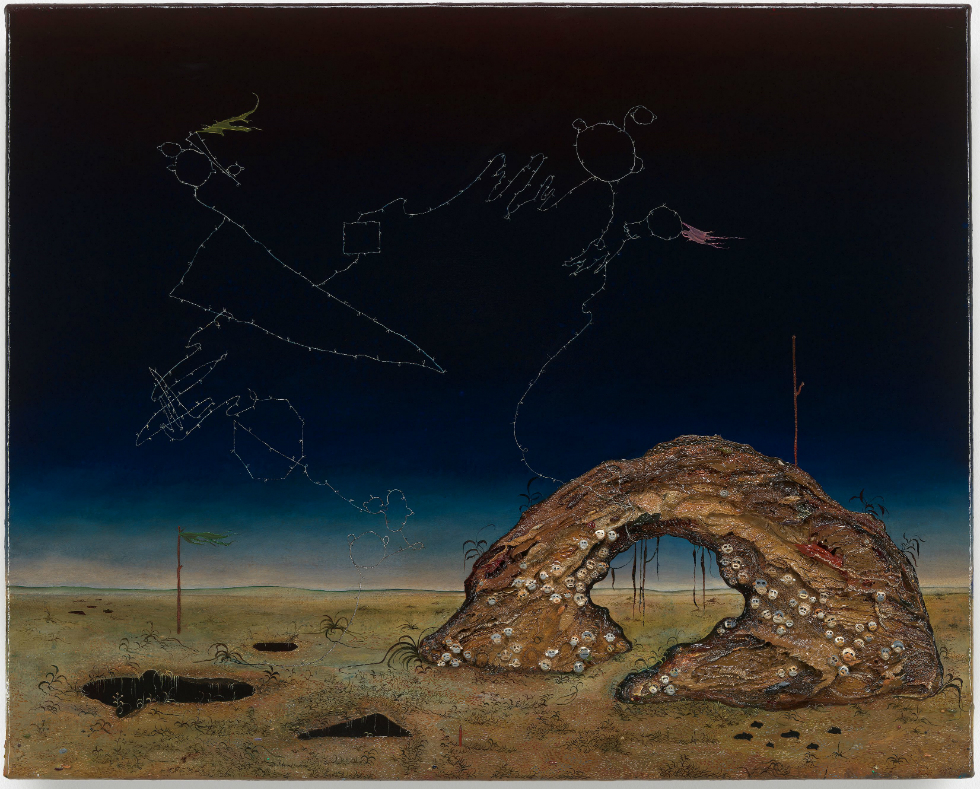The Devil is in the Detail: Anj Smith @ MOSTYN Gallery – Reviewed

Feral landscapes and Anthropocene detritus combine to deliver a fearsome dose of future shock in an exhibition of Anj Smith’s paintings at MOSTYN gallery, finds Mike Pinnington…
The devil is in the detail, they say. Nowhere has this idiom seemed more apt to me recently than in Anj Smith’s current exhibition at Llandudno’s MOSTYN gallery. At first glance, her paintings appear to be typically figurative still lifes, landscapes and portraits. If that sounds unremarkable, nothing is quite as it seems here. Close attention is required and rewarded: the longer you spend in front of one of Smith’s images, and the harder you look, the more is revealed. This is true of both paint – oil on linen, richly and intricately applied – and narrative.
With no extended captions to accompany the works, imagination takes hold; different elements, variously comic and troubling (often both), begin to emerge. Ordinarily disparate elements share the same space, so that the quotidian and arcane rub shoulders, while other binaries are similarly discarded, fluid or merged. 2013’s Portrait of a Boy in Glass is a case in point. If not for the title, you would have a difficult job assigning a gender to the subject, whose cherubic features – thick red lips sit proudly on a face crowned by lustrous blonde locks – belie an otherwise grotesque semiotic patchwork. Downcast eyes draw our own gaze to a furred cuff, dripping with blood; the rest of the visible forearm is stubbled with three-day growth. The boy’s head is covered not by glass but sewn together plastic, while another pair of eyes stare out at us from chipped, yet fastidiously painted fingernails.
Details of a dystopian, near future world abound amid clues – left by Smith like breadcrumbs from a fairy tale – of whatever’s left of a civilisation living on scraps. In Faune, from 2015, a figure sheathed once again in plastic and gloopy plasma stands on roiling, feral ground. Riddled with roots, it points the lost and careless to the underworld. Staking her claim with anything but verdant green shoots, it’s no great leap to imagine an undead zombie Mother Nature listlessly wandering the Anthropocene’s aftermath, or somewhere darker still. In S.O.S. (2016-2017), materials are pieced together from a previous epoch. Old lab equipment, red lipstick and rotting flora and fauna all converge. Meanwhile, a torn trompe l’oeil layer reveals classical arches, connotations of forgotten grand ambitions; a primate, running wild – perhaps recently anointed ruler of this tangled wasteland – glassily returns our gaze. The meek will inherit the earth and humanity’s detritus along with it.

One of the earliest and most striking works on display here is 2012’s The Sentry. It depicts a figure in repose perched on craggy, almost animate land (as in Faune). The titular sentry peers blankly and inscrutably outwards. Wearing a headdress of leaves, twigs and weeds, its legs covered in painted flowers and monkey faces, the ambiguous figure appears to hold aloft a mess of its own innards. “Behold,” seems to be the assertion, “for these are the end times.” In Desert Epoch (2014), we see a landscape almost bereft of any evidence that we were ever there. A constellation of barbed wire hangs in the sky, while yet more monkey faces dot the growth to which it is attached, like the cave paintings of a recently lost civilisation.
Drenched with the uncanny, Anj Smith’s paintings are suffused with the Surrealism of Leonora Carrington, along with weird visions akin to those of Willian Blake. Literature rears its head, too, in the form of magic realism and the writings of Angela Carter, whose Out People from the post-apocalyptic novel Heroes and Villains can easily be imagined in the rotting landscape. Lurking in the undergrowth, just out of picture, they are never far off. More than backwards-looking flights of fancy, however, these works bleakly and vividly describe a possible near future. One wrought by late capitalism, in which pompous delegates glibly fly to Davos leaving contrails in their wake, while climate disaster happens before our eyes. Creepy and darkly brilliant, Smith serves up a fearsome dose of future shock.
Mike Pinnington
Anj Smith is in conversation with MOSTYN director Alfredo Cramerotti, this Saturday 25 January at 4pm
The exhibition continues until 1 March 2020
Images: Anj Smith, Desert Epoch, 2014. Copyright Anj Smith. Courtesy the artist and Hauser & Wirth; Anj Smith, S.O.S. 2016-2017. Collection of Alexander V. Petalas





